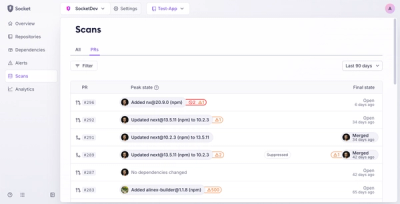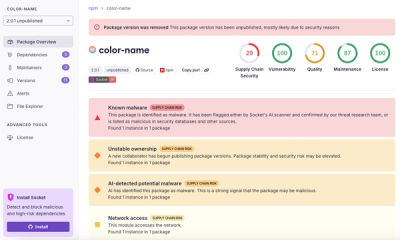
Security News
MCP Steering Committee Launches Official MCP Registry in Preview
The MCP Steering Committee has launched the official MCP Registry in preview, a central hub for discovering and publishing MCP servers.
casdoor-react-sdk
Advanced tools
It can help you quickly build a silent sign-in application based on Casdoor.
We have an implemented example: casdoor-spring-security-react-example.
To use this sdk just follow the steps below.
#NPM
npm i casdoor-react-sdk
#YARN
yarn add casdoor-react-sdk
Let's take a look at the following example of a silent sign-in.
First, you need to initialize the Casdoor SDK.
import Sdk from "casdoor-js-sdk";
export const ServerUrl = "http://localhost:7023";
const sdkConfig = {
serverUrl: "http://localhost:8000",
clientId: "d79fd3c4e09a309fb3f5123",
appName: "application_hnpzib",
organizationName: "organization_4emn5k",
redirectPath: "/callback",
signinPath: "/api/signin",
};
export const CasdoorSDK = new Sdk(sdkConfig);
Then, intercept the /callback path in your application, the AuthCallback component will help you automatically handle the logic of interacting with the server, you just need to make sure that your server ServerUrl implements the ${ServerUrl}/api/signin api, and takes two parameters code and state, and returns token.
Note: Here you need to implement the
saveTokenFromResponseandisGetTokenSuccessfulfunctions.
isGetTokenSuccessful:you need to judge from the response data whether the request is processed successfully by the server.saveTokenFromResponse:when your${ServerUrl}/api/signinapi successfully returns the token, you need to save the token.
import { Route, BrowserRouter, Routes } from "react-router-dom";
import { AuthCallback } from "casdoor-react-sdk";
import * as Setting from "./Setting";
import HomePage from "./HomePage";
function App() {
const authCallback = (
<AuthCallback
sdk={Setting.CasdoorSDK}
serverUrl={Setting.ServerUrl}
saveTokenFromResponse={(res) => {
// @ts-ignore
// save token
localStorage.setItem("token", res.data.accessToken);
}}
isGetTokenSuccessful={(res) => {
// @ts-ignore
// according to the data returned by the server,
// determine whether the `token` is successfully obtained through `code` and `state`.
return res.success === true;
}}
/>
);
return (
<BrowserRouter>
<Routes>
<Route path="/callback" element={authCallback} />
<Route path="/" element={<HomePage />} />
</Routes>
</BrowserRouter>
);
}
export default App;
In your HomePage to determine whether you need to log in silently, if you need to log in silently, return the SilentSignin component, it will help you initiate a login request, and after the login is successful, it will call the handleReceivedSilentSigninSuccessEvent function, and when the login fails, it will also Call the handleReceivedSilentSigninFailureEvent function.
import * as Setting from "./Setting";
import { SilentSignin, isSilentSigninRequired } from "casdoor-react-sdk";
function HomePage() {
const isLoggedIn = () => {
return localStorage.getItem("token") !== null;
};
if (isSilentSigninRequired()) {
// if the `silentSignin` parameter exists, perform silent login processing
return (
<SilentSignin
sdk={Setting.CasdoorSDK}
isLoggedIn={isLoggedIn}
handleReceivedSilentSigninSuccessEvent={() => {
// jump to the home page here and clear silentSignin parameter
window.location.href = "/";
}}
handleReceivedSilentSigninFailureEvent={() => {
// prompt the user to log in failed here
alert("login failed");
}}
/>
);
}
const renderContent = () => {
if (isLoggedIn()) {
return <div>Hello!</div>;
} else {
return <div>you are not logged in</div>;
}
};
return renderContent();
}
export default HomePage;
FAQs
React client SDK for Casdoor
The npm package casdoor-react-sdk receives a total of 502 weekly downloads. As such, casdoor-react-sdk popularity was classified as not popular.
We found that casdoor-react-sdk demonstrated a not healthy version release cadence and project activity because the last version was released a year ago. It has 3 open source maintainers collaborating on the project.
Did you know?

Socket for GitHub automatically highlights issues in each pull request and monitors the health of all your open source dependencies. Discover the contents of your packages and block harmful activity before you install or update your dependencies.

Security News
The MCP Steering Committee has launched the official MCP Registry in preview, a central hub for discovering and publishing MCP servers.

Product
Socket’s new Pull Request Stories give security teams clear visibility into dependency risks and outcomes across scanned pull requests.

Research
/Security News
npm author Qix’s account was compromised, with malicious versions of popular packages like chalk-template, color-convert, and strip-ansi published.